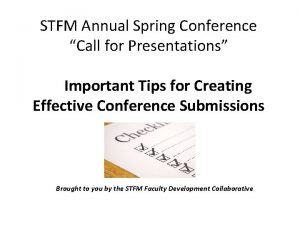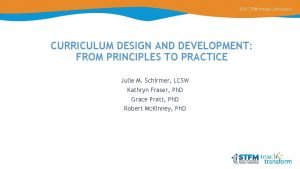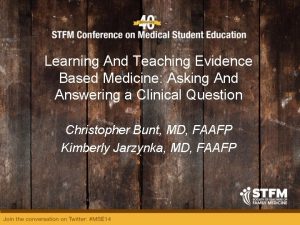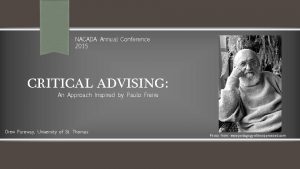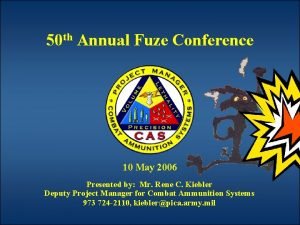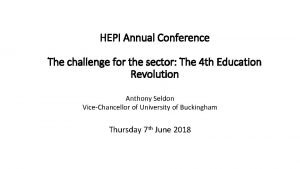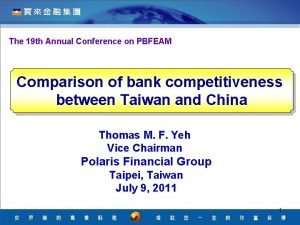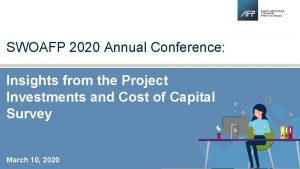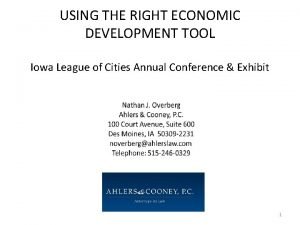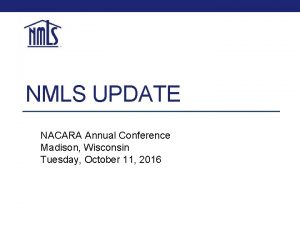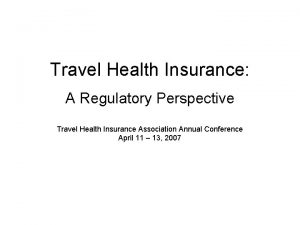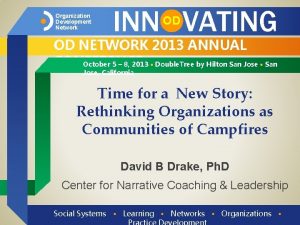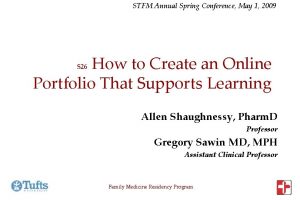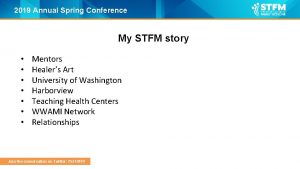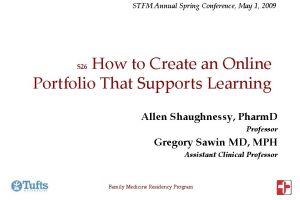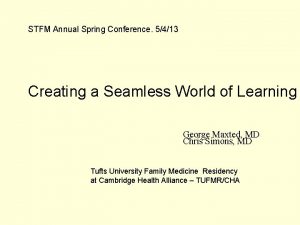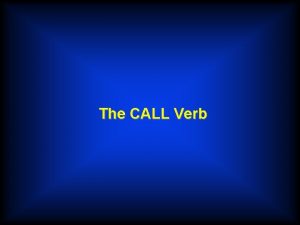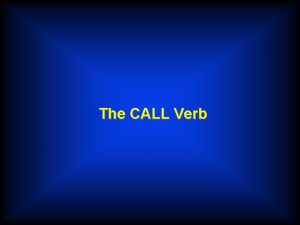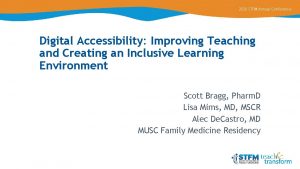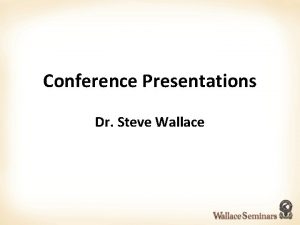STFM Annual Spring Conference Call for Presentations Important















- Slides: 15

STFM Annual Spring Conference “Call for Presentations” Important Tips for Creating Effective Conference Submissions Brought to you by the STFM Faculty Development Collaborative

Contributors: • Tammy Chang, MD, MPH, MS • Nathan Culmer, Ph. D • Monica De. Masi, MD • Joanna Drowos, DO, MPH, MBA • Edgar Figueroa, MD, MPH • Jennifer Hartmark-Hill, MD, FAAFP • Linda Hogan, Ph. D • Tina Kenyon, MSW • John Malaty, MD, FAAFP • Amy Odom, DO • Andrea Pfeifle, Ed. D • David Schneider, MD, MSPH • Katie Westerfield, DO, IBCLC

Introduction: • Success and advancement at academic institutions requires dissemination of scholarly work • Competition for opportunities for presentations is increasing • Institutions may offer support to attend meetings when presenting

STFM Presentation Categories and Submission Content: Pre-conference Workshop 4 -8 hours Workshop 90 mins Panel Discussion 60 mins Seminar 60 mins Lecture-Discussion 30 mins Scholarly Topic Roundtable 50 mins Completed Research Project (oral presentation) 20 mins Completed Project (oral presentation) 20 mins Developing Project Poster (dedicated) 60 mins Completed Research Poster (dedicated) 60 mins Fellows, Residents, or Students Research Works in Progress Poster (dedicated) 60 mins


The Submission: Review call for proposal and deadline Determine topic and presentation format Review submission form Draft submission outline based on required headings • Edit, get feedback and improve submission to meet format and word count requirements • •

STFM Evaluation Criteria: PROPOSAL REVIEW: 1. Abstract is clearly written and summarizes session content accurately 2. Content is relevant to professional activities of family medicine educators 3. Objectives are clear, concise and easily understood, written in required format 4. Does this presentation seem likely to be engaging and actionable for participants? 5. Evaluation: • A description of completed evaluation results - OR • The evaluation method that is in process at the time of submission 6. Submission includes required elements: at least 3 references and timeline (except posters) 7. Overall quality - this score reflects an assessment of how well this submission meets the needs of conference attendees, and whether or not the above required elements are included

Submission Rating Form and Criteria: Ø (Choose one: 1=low score; 5 = high score) Ø Start all scoring from 3 and add or subtract 1 -2 points as appropriate Ø 3 = meets criteria Ø 4 -5 = exceeds criteria to varying degrees Ø 1 -2 = below criteria to varying degrees Ø For ALL SUBMISSION CATEGORIES: Ø Reviewer recommendations for this proposal: Ø Comments: Ø Required for scores > or < 3 Ø - OR Ø If recommending rejection Ø General comments welcome

Common Submission Pitfalls: • Titles that are too whimsical and don’t identify the presentation content • Grammatical errors • Poorly written objectives • Projects that are just in the idea phase when the submission is submitted • No description of how the idea was evaluated (or of evaluation in process at the time of submission) • Failure to include references or time allocation if required (e. g. – not needed for posters)

A Few Pearls: • Follow the directions • Give the reviewers what they are requesting • Write in concise and simple terms – don’t make the submission too complicated • Make it easy to read • Dot points and numbered lists are easier to read than paragraphs • The content of the submission can evolve as you prepare the actual presentation • Preparing a high quality submission can make it easier to create your actual presentation

Glassick’s Criteria: Clear Goals Adequate Preparation Appropriate Methods Significant Results Effective Presentation Reflective Critique

Introduction to SMART Learning Objectives: • • • Specific Measurable Achievable Relevant Timed “On completion of this session, participants should be able to: • identify and describe three primary tenets of the Learner Self-Efficacy Model. "

Appropriate Verbs - Power Verbs for Critical Thinking: (Bloom’s Taxonomy) Anderson, Lorin W. ; Krathwohl, David R. eds. (2001). A taxonomy for learning, teaching, and assessing: A revision of Bloom's taxonomy of educational objectives. Allyn and Bacon. • Knowledge – Define, Identify, Describe, Explain, Recognize, List • Understand – Interpret, Compare, Discuss, Distinguish, Predict • Apply – Demonstrate, Articulate, Prepare, Involve, Report • Analyze – Illustrate, Differentiate, Categorize, Calculate, Adapt • Evaluate – Appraise, Grade, Refine, Support, Decide • Create – Design, Develop, Collaborate, Write, Formulate

Important Tips for Success and Next Steps: Brainstorm about available work, solicit partners Review Call for Proposals – note deadline and logistics Identify level of scholarship achieved Consider categories and best format Prepare submission in an MS Word document first Consider how submission meets review criteria Write SMART Objectives with appropriate verbs Editing! – ask others to review your submission and give feedback before you submit! • Consider feedback from STFM reviewers • •

References: 1. Boyer EL. Scholarship reconsidered: Priorities for the Professoriate 1990; The Carnegie Foundation the Advancement of Teaching: Princeton, NJ. 2. Beasley BW, Simon SD, Wright SM. A Time to be Promoted: The Prospective Study of Promotion in Academia (Prospective Study of Promotion in Academia). Journal of General Internal Medicine. 2006; 21(2): 123 -129. doi: 10. 1111/j. 1525 -1497. 2005. 00297. x. 3. Glassick CE, Huber MR, Maeroff GI. Scholarship Assessed: Evaluation of the Professoriate. 1997; San Francisco, CA: Jossey-Bass. 4. Shapiro ED, Coleman DL. The Scholarship of Application. Acad Med. 2000; 75(9): 895 -8. 5. Chatterjee D, Corral J. How to Write Well-Defined Learning Objectives. The Journal of Education in Perioperative Medicine JEPM. 2017; 19(4): E 610.
 Stfm abstract submission
Stfm abstract submission Stfm conference
Stfm conference Pico question stfm
Pico question stfm Gie annual conference
Gie annual conference Gcyf 2011 annual conference
Gcyf 2011 annual conference Nacada annual conference
Nacada annual conference Annual fuze conference
Annual fuze conference Njdv
Njdv Hepi conference
Hepi conference Pbfeam
Pbfeam Https //bit.ly2v
Https //bit.ly2v Iowa league of cities annual conference
Iowa league of cities annual conference Nmls resource center
Nmls resource center Travel health insurance association annual conference
Travel health insurance association annual conference Organization development network annual conference
Organization development network annual conference Giduk
Giduk
